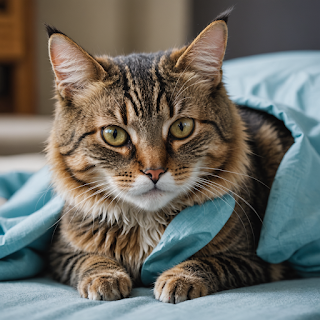Introduction
Cats are masters at hiding illness, making proactive health care essential for their longevity. Whether you’re a new cat parent or a seasoned owner, this guide covers everything you need to know about feline wellness—from kittenhood to the golden years. Let’s dive into nutrition, preventive care, mental health, and more to ensure your cat thrives.
1. Cat Nutrition: Building the Foundation for Health
Keyword Focus: "best cat diet," "wet vs. dry cat food," "cat hydration tips"
Understanding Dietary Needs by Life Stage
Kittens: High-protein, calorie-dense food for growth (e.g., Royal Canin Kitten).
Adults: Balanced meals with taurine and omega-3s (look for AAFCO-certified brands like Hill’s Science Diet).
Seniors: Lower-calorie, high-fiber formulas to aid digestion (e.g., Purina Pro Plan Senior).
Wet Food vs. Dry Food: Pros and Cons
Wet Food: Hydration boost, ideal for cats with kidney issues. Top Pick: [Wellness CORE Grain-Free Pâté](affiliate link).
Dry Food: Dental benefits, but may contribute to dehydration.
Hydration: Why It’s Critical
Cats evolved from desert animals and have a low thirst drive.
Solutions: Provide multiple water bowls, use a cat fountain ([Pioneer Pet Raindrop](affiliate link)), or add broth to meals.
Supplements to Consider
Omega-3s: For skin and coat health (Nordic Naturals Omega-3 Pet).
Probiotics: To aid digestion (Purina FortiFlora).
2. Common Cat Health Issues & How to Prevent Them
Keyword Focus: "signs of cat illness," "cat urinary tract health," "feline diabetes prevention"
Urinary Tract Disease (FLUTD)
Symptoms: Straining to pee, blood in urine, excessive licking.
Prevention:
Feed moisture-rich diets.
Use stress-reducing pheromone diffusers ([Feliway](affiliate link)).
Dental Disease
Stats: 70% of cats develop dental issues by age 3.
Prevention:
Brush teeth with cat-safe toothpaste (Virbac C.E.T. Enzymatic).
Offer dental treats (Greenies Dental Cat Treats).
Obesity
Risks: Diabetes, arthritis, heart disease.
Solutions:
Measure portions with a kitchen scale.
Use interactive feeders ([Catit Senses 2.0](affiliate link)) to slow eating.
Parasites
Fleas, Ticks, and Worms: Monthly preventatives like Revolution Plus.
3. Preventive Care: Vaccines, Checkups, and Grooming
Keyword Focus: "cat vaccination schedule," "how to groom a cat," "indoor cat vet visits"
Essential Vaccines
Core Vaccines: Rabies, FVRCP (feline distemper).
Non-Core: FeLV (for outdoor cats).
How Often to Visit the Vet
Kittens: Every 3–4 weeks until 16 weeks old.
Adults: Annual checkups.
Seniors: Biannual visits for bloodwork.
Grooming Tips by Coat Type
Short-Haired: Weekly brushing (SleekEZ Deshedding Tool).
Long-Haired: Daily brushing to prevent mats (Chris Christensen Slicker Brush).
4. Mental Health & Environmental Enrichment
Keyword Focus: "cat anxiety solutions," "how to entertain a cat," "cat stress signs"
Signs of Stress
Hiding, overgrooming, aggression.
Enrichment Ideas
Vertical Space: Cat trees ([Frisco 72-in](affiliate link)).
Puzzle Feeders: Outward Hound Fun Feeder.
Interactive Play: Da Bird teaser wand (mimics prey movement).
Managing Multi-Cat Households
Provide separate resources (litter boxes, food bowls).
Use calming collars ([Sentry HC Calming Collar](affiliate link)).
5. Senior Cat Care: Navigating Aging Gracefully
Keyword Focus: "senior cat symptoms," "cat arthritis treatment," "end-of-life care"
Age-Related Health Changes
Arthritis:
Symptoms: Limping, reluctance to jump.
Solutions: Ramps, heated beds ([K&H Thermo-Kitty Mat](affiliate link)), joint supplements (Cosequin).
Kidney Disease:
Feed prescription diets (Hill’s k/d).
Subcutaneous fluids for hydration.
Comfort Modifications
Low-sided litter boxes (Nature’s Miracle High-Sided).
Soft, orthopedic bedding.
6. When to See the Vet: Emergency Red Flags
Keyword Focus: "cat emergency symptoms," "is my cat sick quiz"
Urgent Symptoms
Difficulty breathing, seizures, sudden paralysis.
Non-Urgent But Concerning: Vomiting >24 hours, lethargy, weight loss.
First-Aid Kit Essentials
Styptic powder (for nail bleeding), digital thermometer, gauze.
FAQs About Cat Health
"How can I tell if my cat is in pain?"
Signs: Hiding, reduced appetite, dilated pupils.
"Are grain-free diets bad for cats?"
No, but ensure they’re high in animal protein.
"How do I introduce a new food without upsetting their stomach?"
Transition slowly over 7–10 days.
Conclusion
Your cat’s health is a lifelong commitment, but with the right knowledge, you can prevent many issues and catch others early. Bookmark this guide, share it with fellow cat lovers.
Need a Professional Cat Care? Check out this page.
